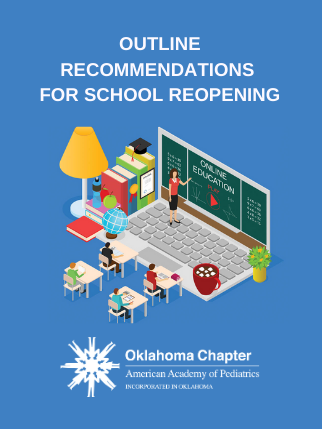
Recently, the American Academy of Pediatrics (AAP) released guidance on re-opening schools. The AAP states a clear “goal of having students physically present in school” yet stresses that “this should happen with careful measures to keep students and staff safe, and with flexibility to adapt as needed to the community’s prevalence of COVID-19.” The AAP statement also outlined comprehensive guidance that included age-specific suggestions to mitigate potential spread, suggested higher- and lower-priority strategies for schools, and made recommendations focused on specific activities and populations. OKAAP and OAFP support the AAP statement.
Given this guidance, at this time OKAAP and OAFP cannot support a statewide return to in-person school decision for Oklahoma in August. While some counties may have extremely low rates of spread, others have growing numbers of positive cases or consistently high positive test rates indicating that community spread is uncontrolled and testing is not yet sufficiently reaching all infected people. Additionally, safety policies and resources are not standardized across the state, leading to inequitable protection for children, teachers, and families.
To ensure a safe school setting in Oklahoma, OKAAP and OAFP recommend the state prioritize the following strategies, which should be implemented in partnership with educators, administrators, parents, and students.
• Local, Data-Driven Decisions. OKAAP and OAFP believe there should be clear guidance from the state on specific, county-level data indicators that show it is safer to open specific school districts. The White House Opening Up America Again plan suggests reopening schools (Phase 2) when a region has a downward case trajectory OR downward trajectory for the percentage of positive tests (provided there’s sufficient testing) for 14 days. In a similar, but more conservative approach than the color-coded map suggested by the Oklahoma State Board of Education on 7/23/20, we recommend that counties be in the globalepidemics.org/key-metrics-for-covid-suppression/ yellow or green zone (0-10 new cases per 100,000 population) before resuming in-person instruction. OKAAP and OAFP support using, at minimum, these criteria to plan for safe re-opening at the county level. Public health data should not be used only to shut down schools because of an outbreak.
• K-12 Mandatory Masks. OKAAP and OAFP recommend a requirement in schools for mandatory K-12 student and teacher masks. Universal use of masks is the state’s best tool to prevent spread.
• Social Distancing. OKAAP and OAFP believe districts need clearer guidance on how to achieve social distancing and smaller, consistent cohorts of students. This will likely require fewer students to be in school buildings at any given time. Districts should be granted approvals to allow them to expand into space in community centers or to use creative scheduling to allow for social distancing when they open.
• State Purchasing Power. The AAP is advocating for federal funds to support safe public school re-opening. As they have thankfully done for the medical community, the state should utilize its purchasing power to obtain and distribute needed PPE, hand hygiene and cleaning supplies, and sanitation materials, including full medical PPE for all public school nurses, building first responders, and teachers/para-professionals in self-contained/special needs classrooms.
• Clear Communication. The OKAAP and OAFP believe a strong alliance should be established between the health care community, the Oklahoma State Department of Education and the Oklahoma State Department of Health to ensure clear guidance is given to school districts across the state.
OKAAP and OAFP members are committed to working with state leaders to develop safe return to school plans, including strategies not mentioned here, such as policies for return to school following an illness, contact tracing within schools, quarantine instructions in the setting of positive cases, and providing for meals and other essential services when schools cannot meet in-person.
OKAAP and OAFP join all state leaders in emphasizing the importance of well-child visits, immunizations, and flu shots this year to ensure that children’s physical and emotional needs are being addressed during the pandemic.
For more information contact:
Kari Webber, CAE
405-323-7173
kari.webber@okaap.org
